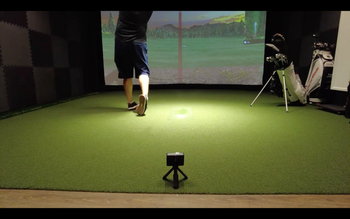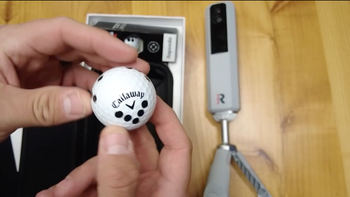Here's what matters most when you're choosing shafts: mass (steel ranges from 95-130 grams while graphite sits at 40-115 grams), price point (steel won't break the bank but graphite's carbon fiber tech costs more), vibration response (steel delivers sharp feedback versus graphite's cushioned impact), accuracy versus distance debate (steel provides control while graphite adds yards), and player matching (newcomers and skilled players often pick steel for its honesty, but older golfers and those with sore joints love graphite's comfort)—let's dig into which shaft type will actually improve your scores.
Mass and Velocity Effects on Your Shots
Shaft weight makes a huge difference in how you'll strike the ball, it's not some minor factor you can ignore! Steel options typically run 95-130 grams, but graphite alternatives come in much lighter at 40-115 grams.
That reduced mass in graphite translates directly to faster clubhead movement, giving you more distance off each strike. If you're not swinging as fast as you used to, graphite becomes your secret weapon, it'll generate more speed without forcing you to swing harder.
Here's the trade-off, though. Steel's added heft provides superior shot control and repeatability. Picture it this way: graphite feels like whipping a sports coupe around corners, but steel handles like a reliable SUV. Graphite delivers velocity, yet steel brings that predictable consistency many skilled players won't give up.
Something else worth noting, graphite dampens impact shock significantly better than steel, making your body feel better after contact. Your wrists and elbows will appreciate this cushioning during those marathon practice days!
Also interesting: The majority of retail irons feature a D2 balance point, that's simply the industry benchmark for how clubs should feel during your swing.

Longevity and Price Points
Looking at golf clubs as a serious purchase means you'll want to know how steel versus graphite performs long-term, plus what damage they'll do to your bank account initially.
Steel takes the trophy for toughness without question. These shafts handle constant use like champions and keep performing reliably. Their durability makes them perfect for players hitting balls several times weekly. Steel handles different weather and course conditions while keeping its characteristics intact through many seasons.
Graphite holds up well, also, though it needs more careful treatment to avoid premature aging, particularly without regular care.
Now for the wallet impact: steel costs way less than graphite alternatives. Those fancy carbon materials in graphite push prices up significantly. For golfers watching their spending or those who like switching gear often, steel delivers great value while still performing consistently round after round.
Touch, Response, and Shock Absorption
Price aside, how shafts transmit sensations through your grip affects both your scoring and how much fun you're having out there. Steel provides clear, immediate response with each strike. You'll know instantly if you caught it flush or missed the sweet spot. This sharp feeling results from steel's rigid properties.
Graphite works differently. It muffles impact vibrations substantially, producing a softer sensation that treats your body better. For players dealing with joint pain or stiffness, graphite's cushioning effect changes everything! But this comfort reduces your awareness of minor swing flaws. The carbon construction specifically targets shock reduction. Players over 50 really appreciate how graphite eases joint stress.
Check this out: graphite shines during extended range time by fighting fatigue, though steel maintains superior shot awareness.
Control Compared to Length Benefits

Deciding on steel or graphite means confronting golf's eternal question: Should you go for laser-like precision or those coveted extra yards?
Steel provides unwavering accuracy due to its stiffness, helping your club stay perfectly aligned through contact for consistent shot shapes. Choose these when hitting specific targets matters more than anything. Meanwhile, graphite adds yardage because of its reduced mass; you'll generate more speed and longer hits, particularly helpful for moderate swing speeds.
Get this: current graphite engineering nearly matches steel's accuracy! Modern high-end graphite gives you steel's reliability plus that yardage boost. Still, graphite might spread your misses wider because of its flex, creating bigger errors on poor strikes. Today's steel comes lighter too, down near 85 grams, helping average players handle them better. The mass gap remains big, steel averages 128 grams compared to graphite's 80-90 gram range.
Player Matching by Ability and Body Considerations
Selecting steel or graphite depends heavily on your playing ability and physical situation when determining what'll actually lower your scores. New players find Steel's clear response teaches them about swing errors, accelerating improvement. Experienced golfers usually want steel's accuracy for repeatable trajectories.
Your body's needs count equally! Older players and anyone with joint issues love graphite's reduced mass and impact cushioning. Dealing with spine issues? Graphite takes major pressure off. Players with higher scores frequently gain yards using graphite, and slower swingers achieve that vital speed boost they're missing.
Plenty of players discover graphite helps ease pain in frequently stressed areas, especially beneficial for those nursing old injuries. Tour players generally use steel ranging from 115-130 grams for maximum precision and feel.
Common Questions
Is It Possible to Mix Steel and Graphite in My Iron Set?
You can't simply interchange steel and graphite between irons in your bag. Every shaft demands expert fitting involving specialized equipment. Remember, changing means removing, adjusting, and reassembling individual clubs. It's complicated work! You'll require a certified fitter's expertise, plus costs add up quickly. Stick with one shaft material throughout for better rhythm.
What About Weather Effects on Different Shaft Materials?
Weather changes how your shafts behave significantly. Steel performs better during breezy rounds since its mass creates penetrating flights that resist wind better. Graphite has trouble in gusts because it launches higher, letting wind affect shots more. When temperatures drop, graphite becomes less flexible and feels harder, but steel stays predictable no matter the mercury reading.
Does Graphite Need Special Care Versus Steel?
Absolutely, graphite demands gentler treatment compared to steel. You've got to be careful since it damages more readily and might develop fractures. Wash graphite using gentle cleanser and warm water, skipping strong products that could harm the surface. Steel tolerates abuse better—it survives tough conditions and careless handling. Keep graphite protected from impacts that cause damage.
Will Shaft Type Change What My Clubs Are Worth Later?
Your shaft choice absolutely affects future selling prices! Graphite costs extra initially yet loses value quicker than steel options. Steel maintains worth longer thanks to superior longevity and wider buyer appeal. Still, high-quality graphite from respected manufacturers keeps reasonable prices. Main considerations include wear level, manufacturer standing, and buyer interest in that particular shaft model.
Do Companies Make Shafts Mixing Both Materials?
Absolutely, combination shafts merge advantages from each material! Brands including Aerotech's SteelFiber HLS and Nippon's MODUS(3) employ special methods mixing materials together. You'll experience steel's control and response alongside graphite's distance and bend. They produce medium-to-high trajectories featuring improved spin management and narrower miss patterns. They're offered across various masses and bend profiles for different swing rhythms.
Final Thoughts
Picking steel or graphite ultimately depends on what matters most in your specific situation. Need accuracy and response? Steel's your answer. Looking for extra yards and smoother swings? Graphite fits perfectly. Don't overthink this decision, test each type at your golf shop and trust what feels natural. Both your budget and handicap will appreciate the right choice!





